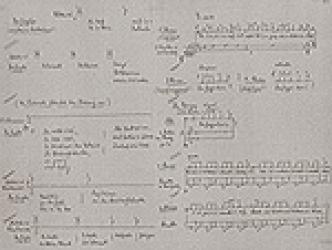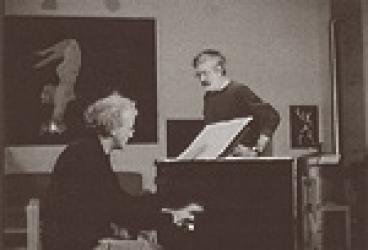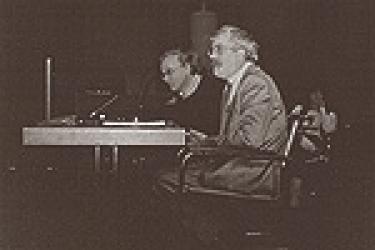Michael Ende and Music
 Score for 'Der Goggolori'
Score for 'Der Goggolori' Michael Ende found a kindred spirit in composer Wilfried Hiller
Michael Ende found a kindred spirit in composer Wilfried Hiller Michael Ende and Wilfried Hiller were determined to unite literature and music in an art form suited to their times
Michael Ende and Wilfried Hiller were determined to unite literature and music in an art form suited to their timesArt and literature were an integral part of Ende’s childhood, but music played a less prominent role. Ende set some of his texts to music and would often perform his songs to friends, accompanying himself on the guitar. His compositions included ‘Die Papiertragödie’ (‘The Paper Tragedy’) and ‘Die Ballade vom nächtlichen Regen’ (‘The Ballad of Eventide Rain’).
Over time Michael Ende became increasingly interested in the idea of literary-musical collaborations. He started working with the composer Mark Lothar, who wrote the libretto Momo und die Zeitdiebe (‘Momo and the Time Thieves’), for which Ende produced the script in 1975. The libretto was premiered in Coburg on 19th November 1979.
In 1976 Michael Ende asked the composer Hans Posegga to write musical scores for some of his ballads and chansons. Ende envisaged compositions in the tradition of the Italian cantautori and the French chansonniers - simple melodies with guitar accompaniment.
Ende admired the music of Jacques Prevert, Jacques Brel, Angelo Branduardi and Fabrizio de André, and wanted something similar for his songs. At first Hans Posegga was keen for Ende to perform the chansons himself, but Ende hastily declined. In 1978 a recording was made of Hans Posegga’s score, accompanied by full orchestra and sung by the actor Klaus Löwitsch. Preparations were made for an LP, ‘Narrenprozession’ (‘Procession of Fools’), but Michael Ende was alarmed by the result. After consulting with his publishers he took the decision not to release the LP. Nonetheless, Posegga’s melodies weren’t lost for perpetuity, and Michael Ende used to perform some of the chansons to friends at evening gatherings, accompanying himself on the guitar.
Wilfried Hiller and Michael Ende had so much in common that they almost seemed fated to meet. Hiller had studied under Carl Orff, and lived with his wife Elisabeth Wouska in Villa Massimo, seat of the Germany Academy in Rome. In 1978 he visited the Endes in Genzano. An artistic and personal rapport was soon established, and the encounter was beneficial on both sides, giving rise to a host of new ideas. By the end of the first meeting the two men had already laid down plans for a collaborative project.
Michael Ende was always eager to find kindred spirits - writers, artists and musicians - whose creative vision was commensurate with his own. He aspired to a synthesis of art forms, and in Wilfried Hiller he found the composer with whom he could develop collaborative projects involving music and text. Their first meeting in Italy marked the start of a long and productive partnership that lasted until Ende’s death. Over the next seventeen years Wilfried Hiller set a number of Michael Ende’s texts to music, as discussed in more detail below.